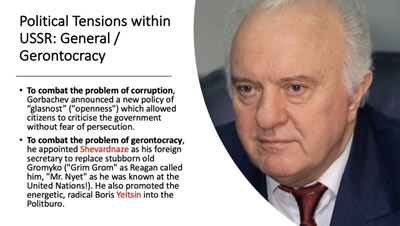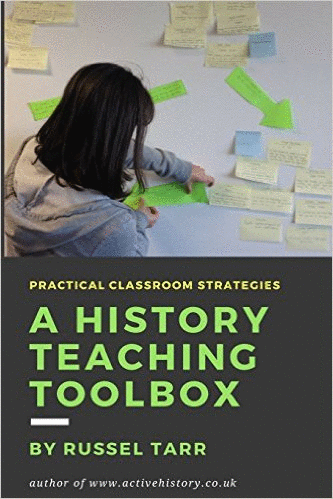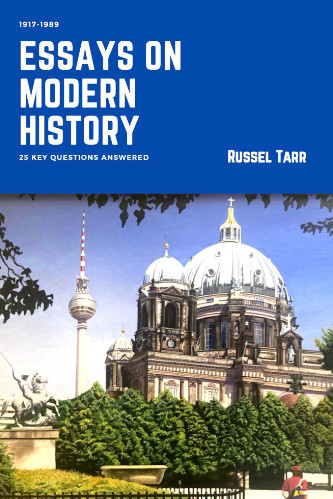World History teaching resources for the high school classroom: lesson plans, worksheets, quizzes and simulation games for KS3, IGCSE, IB and A-Level teachers.
The CIE History IGCSE Sourcework Paper for Summer 2022 will focus on Key Question [6]: "How secure was the USSR's control over Eastern Europe, 1948-c.1989?".
These comprehensive ActiveHistory materials can be used to deliver this entire topic effectively to students. I have also designed some topical resources covering Why did the USA withdraw from Afghanistan in 2021 and what does the future hold?

Overview: Eastern Europe 1945-1991
Students are provided with an essential narrative, and produce their own account of the events of 1989-91 by comparing and making deductions from two maps of Europe during the period.
1956: The Hungarian Revolution
What is the difference between a rebel, a traitor, a freedom fighter, a terrorist and a revolutionary? At the end of this lesson, students will consider which of these labels they would use to describe the people who took part in the Hungarian uprising of 1956. A comprehensive workpack complete with sourcework exercises.
1949-1960: The Berlin Crisis
The division of Germany into four zones of occupation at the end of World War Two, and the division of Berlin (deep in the Soviet zone of Germany) was never intended to be permanent. However, as the Cold War set in, this weird arrangement became a major source of tension between the Superpowers. Particularly problematic was the status of West Berlin as a capitalist democracy in the heart of an East Germany controlled by a communist dictatorship.
1960-61: The Berlin Wall Crisis Roleplay | Multimedia teacher-led presentation | Briefing Sheets
In this exercise students will take the role of an advisor to President Kennedy. By discussing different courses of action and then comparing them to what Kennedy did, they will form a balanced judgement on his handling of the Berlin Crisis of 1961. The class will be divided into five groups and given five different scenarios from different points during the crisis. Within each group, half the students will be required to construct a case in favour of the first course of action that is proposed, whilst the other half will construct a case in favour of the second. The teacher will then chair the debate before telling students what Kennedy did at each stage through a multimedia presentation.
1961: The Berlin Wall is Built
A video worksheet with follow-up sourcework questions. Between 1949 and 1961, over 3 million people escaped to the West via East Berlin. In June 1961, East Berlin mayor Walter Ulbricht reassured Berliners that "nobody has any intention of building a wall". Nevertheless, on Saturday August 12, 1961, a heavily armed barbed wire fence was built overnight along the frontier between East and West Berlin. The tide of East Germans flooding to the West abruptly ended. A model answer to the sourcework question within this workpack can be found here.
Video worksheet: Life in East Germany under Communism | Teacher notes
In this exercise students will watch a video documentary which will teach them more about what it was actually like to live under a communist regime, and make notes on the witnesses shown in the worksheet.
1968: The "Prague Spring" in Czechoslovakia
In January 1968, against the background of economic problems and student demonstrations, Alexander Dubcek was appointed leader of the Czechoslovak government. Controversially he began to introduce economic and political reforms which he called "Socialism with a human face". The flowering of debate and democracy that followed became known as 'the Prague Spring'. In this lesson, students will investigate the causes, events and consequences of what happened using multimedia, written and visual sources to answer the question "To what extent was the Soviet Union forced to invade Czechoslovakia in 1968?"
How similar were the Hungarian Revolution and the Prague Spring?
A completed grid, ideal as a student handout for revision purposes.
1979: The Soviet Invasion of Afghanistan
The decision of the USA to withdraw from Afghanistan in 2021 was every bit as controversial as its decision to invade in the first place more than 20 years earlier. What is less well known is that the Soviet Union made a similarly disastrous decision to invade Afghanistan in 1979, and that the British and Russians had been dragged down in the same way in the 19th Century. To bring this topic into the modern era, there are also materials available on Why did the USA withdraw from Afghanistan in 2021 and what does the future hold?
1981: The "Solidarity" Movement in Poland | Teacher notes
After the USSR crushed opposition in Hungary (1956) and Czechoslovakia (1968), the focus for dissent moved to the "Solidarity" movement in Poland. Led by Lech Walesa and supported by the Polish Pope John Paul II, this showed that it was possible to successfully rebel against communist control. In this lesson, students compare and contrast the roles of Pope John Paul II, Lech Walesa and General Jaruzelski in the events of 1981 using various sources. Sourcework questions are also provided.
Comparing and Contrasting Communist Control in Poland, East Germany, Hungary and Czechoslovakia
Students are provided with an illustrated table to help them consolidate their understanding so far by comparing and contrasting the causes, events and consequences of events in four Warsaw Pact countries.
1970s: Military Problems for the USSR
Another pressure upon the Soviet Union was the massive cost of keeping up with the United States in terms of nuclear weapons. Students answer questions based around a timeline and as an extension activity conduct some research into the Cuban Missile Crisis.
1980s: Economic and Social Problems in the USSR
Students additional notes from two video clips about the impact of this system on the lives of citizens living under communist rule. The Communist belief in equality meant that everyone got the same wages for their work. Although this meant nobody starved, it also meant there was no incentive to work hard. Over time, the economy stagnated, and living standards declined. The USSR became characterised by poor housing, empty shops, chronic industrial pollution, and such poor health that the government banned the publication of life expectancy figures.
1980s: Diplomatic Problems for the USSR: Reagan and Thatcher
President Ronald Reagan of the USA contributed to the collapse of the Soviet Union by kick-starting a "New Cold War" accelerated the arms race between the Superpowers and thereby placed unbearable pressures upon the fragile Soviet economy. Reagan was fortunate to come to power at the same time as other committed anti-communists. For example, Margaret Thatcher, Prime Minister of Britain, was a formidable ally of Reagan and was soon nicknamed "The Iron Lady" by the USSR.
1980s: Political Problems for the USSR: The Gerontocracy
Another reason for the decline and collapse of Soviet Control in Eastern Europe is that the USSR in the early 1980s was being run by a series of old, sick men who were unable to provide strong, decisive leadership. The Soviet political system at this time was referred to as a "Gerontocracy" – rule by geriatrics. This was the "Era of Stagnation" when the Kremlin was "doubling as a geriatric ward and a funeral parlour" (Mandelbaum).
 1985-1989: Gorbachev - Glasnost and Perestroika | Multimedia Presentation | Teacher notes
1985-1989: Gorbachev - Glasnost and Perestroika | Multimedia Presentation | Teacher notes
In 1985, Mikhail Gorbachev became leader of the USSR. He was comparatively young (54), energetic and charming. More importantly, he was determined to make a difference. Students complete a table which helps them to assess the problems Gorbachev faced, how he chose to deal with them and how appropriate they consider these policies were. A multimedia presentation accompanies this lesson to provide feedback on the above activity. Each slide outlines what Gorbachev actually did, and is followed by a video clip from which students can take additional notes.
1989-1991: The Collapse of Communism in Eastern Europe and Within the USSR
Across the Soviet bloc, Gorbachev’s reforms unleashed forces he could not control. Perestroika and glasnost were introduced too quickly and without sufficient preparation. As a result, economy, society and government were thrown into chaos. Food shortages, violent demonstrations and political instability followed. This culminated first in the Warsaw Pact countries breaking away, and then the USSR itself collapsing.
How far was Gorbachev responsible for these developments, which Putin called "The greatest geopolitical disaster of the 20th century?"
Revision Quizzes / Resources
Podcast: How and why did the Cold War come to an end?
The hosts primarily explore the reforms initiated by Mikhail Gorbachev within the Soviet Union and the multifaceted factors contributing to the end of the Cold War. Gorbachev's policies of glasnost (openness) and perestroika (economic restructuring) aimed to address political and socio-economic issues within the USSR and ease international tensions. The podcast also examines the arms race between the US and the Soviet Union, alongside the revolutions in Eastern Europe and the symbolic fall of the Berlin Wall as critical elements in this historical shift. Ultimately, the documents suggest a complex interplay of internal Soviet reforms and external pressures that led to the dissolution of the Eastern Bloc and the conclusion of the Cold War.
Sourcework Tips: Decline and Collapse of Soviet Control in Eastern Europe
A student handout highlighting the main periods, people and events so that sources can be placed into their correct historical context as specifically as possible.
Interactive Cartoon Analyise: The Decline and Collapse of Communism
In this activity, students analyse 5 separate political cartoons relating to the decline and collapse of communism in Eastern Europe. They are then able to compare their answers to a series of model answers. A useful way of revising the 2010 IGCSE Paper 2 Topic.
Fling the Teacher Challenge: Internal Factors
Fling the Teacher Challenge: External Factors
Fling the Teacher Challenge: The Role of Gorbachev
Fling the Teacher MEGA Challenge: How secure was the USSR's control over Eastern Europe, 1948-c.1989?

© 1998-2025 Russel Tarr, ActiveHistory.co.uk Limited (Reg. 6111680)
1 Torrin Drive, Shrewsbury, Shropshire, SY3 6AW, England
Privacy Policy | Contact






